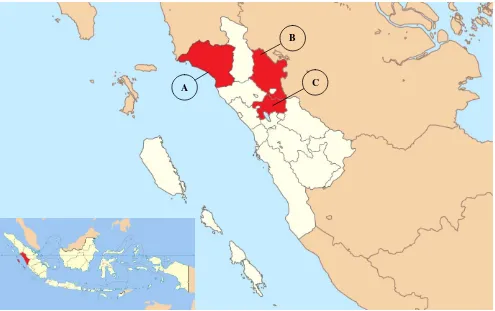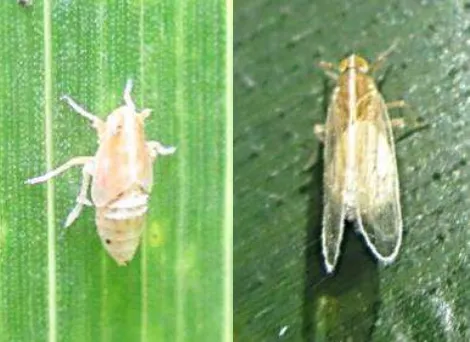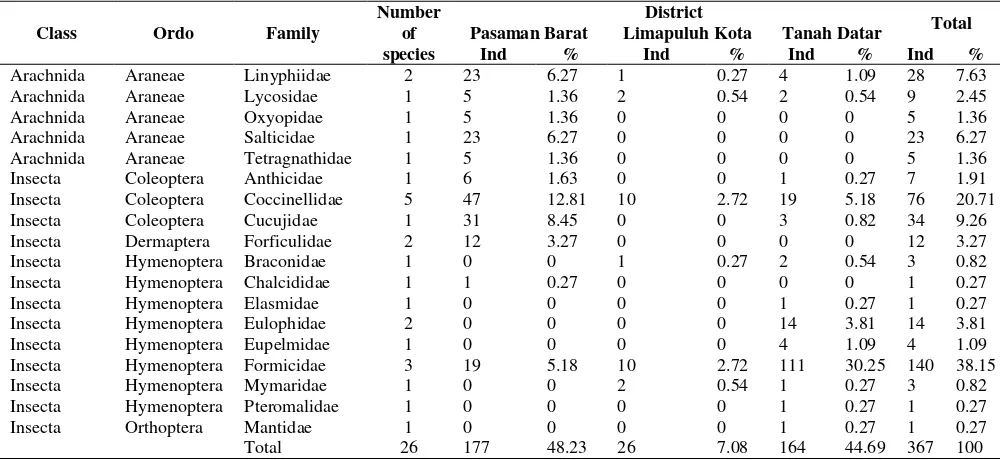Abundance of corn planthopper (
Stenocranus pacificus
) (Hemiptera:
Delphacidae) and the potential natural enemies in West Sumatra,
Indonesia
NOVRI NELLY, MY SYAHRAWATI, HASMIANDY HAMID
Department of Plant Protection, Faculty of Agriculture, Universitas Andalas. Kampus Unand Limau Mani, Pauh, Padang 25165, West Sumatra, Indonesia. Tel.: +6275172701, Fax.: +62-751-72702, email: [email protected]
Manuscript received: 19 October 2016. Revision accepted: 8 April 2017.
Abstract. Nelly N, Syahrawati M, Hamid H.2017. Abundance of corn planthopper (Stenocranus pacificus) (Hemiptera: Delphacidae) and the potential natural enemies in West Sumatra, Indonesia. Biodiversitas 18: 696-700. A study about the abundance of corn planthopper Stenocranus pacificus and diversity of it's potential natural enemies in West Sumatra, Indonesia was conducted from July until October 2016 in Pasaman Barat, Limapuluh Kota and Tanah Datar. The method was purposive random technique sampling. Sampling Stenocranus pacificus Kirkaldy (Hemiptera: Delphacidae) and it's potential natural enemies were collected by using a modified d-vac vacuum. The Identification was done based on morphological differences between species. The result showed that corn planthopper was found in all study location, as well as natural enemies could be found in the vegetative and generative phase of corn. The distribution pattern of corn planthopper, S. pacificus generally was aggregated, except on the vegetative phase in Pasaman Barat that classified as uniform. The natural enemies that found consist of two class (Insects and Arachnids) and three ordo (Hymenoptera, Coleoptera and Araneae). Diversity index (H) of natural enemies in Pasaman Barat is higher than Tanah Datar and Limapuluh Kota district. Evenness index at all study locations showed low value (E<1).
Keywords: Corn, planthopper, diversity, natural enemies
INTRODUCTION
Corn has long been a staple food in several regions in Indonesia, such as Madura, Nusa Tenggara and Gorontalo because it contains dietary fiber with a low glycemic index compared to rice, so that the corn has been recommended for diabetics (Suarni 2009). Furthermore, the corn is also the main ingredient of animal feed and industry needs (Suarni and Yasin 2011).
Planthopper that attacked corn was Peregrinus maidis (Hemiptera: Delphacidae), limited the increase of corn production (Sudjak 2013). It was reported as a serious pest in Hawaii because transmitting the corn mosaic virus (rao virus and tenui virus) and causing "hopperburn" (Nault and Knoke 1981; Takara and Nishida 1983), P. maidis was attacking the corn from most of the humid tropical and subtropical regions of the world including Africa, India, Malaysia, Taiwan, Indonesia, Australia (Metcalf, 1943) and China (Tsai et al. 1986), but for this study showed that the corn planthopper in West Sumatra, Indonesia, was Stenocranus pacificus Kirkaldy (Hemiptera: Delphacidae). Stenocranus was a pest invasive on corn in the Philippines, firstly inserted into the genus Sogatella, but the insect eventually was confirmed as S. pacificus (Cayabyab et al. 2009). Dumayo et al. (2007) reported, there was white waxy substance in the abdomen of female, which was absent in male. Then, Cayabyab et al. (2009) informed that the nymph and adult of S. pacificus attacked the corn
by sucking plant sap from young leaves and leaf sheaths which could lead to stunted plant growth. The formation of a droplet of honeydew on leaves caused galls along veins and underneath leaf surface that resulted in the loss of plant vigor and stunting.
Many arthropods were classified as natural enemies of S. pacificus in the Philippines, namely Coccinellidae, Araneae, Dermaptera, Diptera (Syrphidae), Odonata, Neuroptera, Hemiptera (Cyrtorhinus lividipennis), and Strepsiptera (Dumayo et al. 2007). Nowadays, there are few reports of Stenocranus distribution and its natural enemies in Indonesia. This study aimed to know about the distribution pattern of Stenocranus and its potential natural enemies in the field, especially in West Sumatra, Indonesia.
MATERIALS AND METHODS
Study sites
Figure 1. Study sites in West Sumatra, Indonesia. A. Pasaman Barat, B. Limapuluh Kota, C. Tanah Datar
Collecting the corn planthopper and it’s natural
enemies
There were two fields of corn cultivation in vegetative phase and two other fields on generative phase for collecting the corn planthopper and its potential natural enemies; each field had a measurement of 400 m2. They were collected from 10 samples (clump) randomly from each field by using D-vac vacuum modified. All collections were put into a bag containing chloroform 95%, then, transferred into the bottle that already contained alcohol 70%. The identifying, counting and grouping were done based various reference, namely: Kalshoven (1981), Reissig et al. (1985), Wilson and Claridge (1991), Goulet and Huber (1993), Heinrichs (1994), Barrion and Litsinger (1995), Amir (2002), Triplehorn and Johnson (2005), and Heong and Hardy (2009).
Data analysis
Corn planthopper distribution
Data were tabulated in Excel program to get the value of population and mean per clump from each location. The distribution pattern was determined by calculating the standard deviation that was compared with the mean. If SD = mean, the planthopper distribution was random, SD > mean, the planthopper distribution was aggregated, and if SD < mean, the planthopper distribution was uniform.
Diversity index of natural enemies
Diversity index of natural enemies was calculated by using Shannon-Wiener index (Krebs 1999):
H” = Index of diversity
pi = number of individual per species/ total species
RESULTS AND DISCUSSION
The abundance and distribution of corn planthopper The corn planthopper, Stenocranus pacificus, was found on all study location, as well as phases of corn (Figure 1 and Table 1). The record of S. pacificus during the collection indicated that phases of corn and location of cultivation played an important role on S. pacificus abundance but did not tend to effect on distribution pattern. S. pacificus abundance tended to be higher in vegetative phase than generative. The highest abundance of S. pacificus on vegetative phase was found in Tanah Datar (15 individual/clump), whereas the lowest was found in Limapuluh Kota (0.25 individual/clump). The highest abundance on generative phase was found in Pasaman Barat (2.50 individual/clump), whereas the lowest was found in Tanah Datar. Distribution pattern generally was aggregated, except on the vegetative phase in Pasaman Barat that classified as uniform (Table 1).
A C
Figure 1.Stenocranus pacificus, the corn planthopper that was found in West Sumatra, Indonesia (left: nymph, right: adult - female)
The potential natural enemies of corn planthopper The record of potential natural enemies indicated that phases of the corn and location of cultivation also played an important role in diversity and abundance of them. In general, there were 19 families of arthropods which potentially as natural enemies of S. pacificus. Ten families were classified as a predator, while nine families were classified as a parasitoid. From 10 predators that found, five of them included in the Order Araneae (spiders), while the others included in the Order Coleoptera, Dermaptera, Hymenoptera, and Mantidae. Meanwhile, all of the parasitoids came from the Order of Hymenoptera, two families (Ichneumonidae and Scelionidae) were only found on vegetative phase, and four families (Braconidae, Elasmidae, Mymaridae, Pteromalidae) were only found on generative (Table 2 and 3).
In the vegetative phase, 14 families of arthropods were found as potential natural enemies, which was dominated by Formicidae (ants) and occupied 78.42% of the total natural enemies that be found in the field. Meanwhile, Anthicidae and Coccinellidae are two families of Coleoptera which had a higher population compared to other natural enemies. The highest Formicidae was found in Limapuluh Kota (37.79%), while the highest Anthicidae and Coccinellidae were found in Tanah Datar (5.17% and 2.74% respectively) (Table 2).
In the generative phase, 18 families of arthropods were found as natural enemies, also dominated by Formicidae (ants), which occupied 38.15% of total natural enemies. Meanwhile, Coccinellidae and Cucujidae are two families of Coleoptera which had a higher population compared to other natural enemies. The highest Formicidae was found in Tanah Datar (30.25%), whereas the highest Cucujidae and Coccinellidae were found in Pasaman Barat (12.81% and 8.45% respectively) (Table 3).
The diversity index of natural enemies generally ranged from 1.09 (low) to 2.55 (medium). The highest diversity index was found in Pasaman Barat (2.55), but the highest evenness index was found in Limapuluh Kota (0.84) (Table 4).
Stenocranus pacificus, was found on all study location. It showed that S. pacificus had widespread in West Sumatra. Heong and Hardy (2009) stated that S. pacificus have distribution in Fiji Island, Western Caroline Island, Palau, and the Philippines. The phases of corn and location of cultivation played an important role on S. pacificus
abundance, natural enemies diversity and it’s abundance. S. pacificus abundance tended to be higher in vegetative phase than generative, on the contrary, the diversity and abundance of natural enemies tended to be higher in generative phase (Table 1 and 2).The high abundance of S. pacificus in vegetative phase is closely related to foraging behavior of the insect belonging piercing-sucking type. According to Havlin et al. (2005), the ability of the insect to take the food from the host will depend on the strict level of the stem. The younger the plant, the easier the corn planthopper to suck needed nutrients. Diversity and abundance of natural enemies tended to be higher in generative phase. A similar phenomenon has been reported in other studies such as Hadi et al. (2013) who studied diversity and abundance of rice stem borer in Central Java. They found the highest diversity of rice stem borer during rice generative phase until ripen and decline in line with the age of rice. Species diversity index in vegetative phase was below 2, while during generative phase until ripening increased above 2. Insect population abundance declined, in the end, vegetative phase and increased at the beginning of reproductive phase until ripen phase.
Table 1. Population (individual/clump) and distribution pattern of corn planthopper on vegetative and generative phase in West Sumatra, Indonesia
Phase of corn Districts Corn planthopper
(mean)
Standard Deviation
(SD) Distribution pattern
Vegetative Pasaman Barat 4.45 2.82 Uniform
Limapuluh Kota 0.25 0.54 Aggregated
Tanah Datar 15.00 23.69 Aggregated
Generative Pasaman Barat 2.50 3.59 Aggregated
Limapuluh Kota 1.70 2.57 Aggregated
Tanah Datar 0.70 1.10 Aggregated
Note: Distribution pattern of corn planthopper; mean = SD, random; mean < SD, aggregated; mean> SD, uniform
Table 2. The abundance of potential natural enemies of corn planthopper on vegetative phase in West Sumatra, Indonesia
Class Ordo Family
Number of species
District
Total Pasaman Barat Limapuluh Kota Tanah Datar
Ind % Ind % Ind % Ind %
Arachnida Araneae Linyphiidae 1 4 1.22 1 0.3 0 0 5 1.52
Arachnida Araneae Lycosidae 2 7 2.13 1 0.3 0 0 8 2.43
Arachnida Araneae Oxyopidae 1 1 0.3 0 0 0 0 1 0.3
Arachnida Araneae Salticidae 1 7 2.13 1 0.3 0 0 8 2.43
Arachnida Araneae Tetragnathidae 1 2 0.61 0 0 0 0 2 0.61
Insecta Coleoptera Anthicidae 1 1 0.3 0 0 17 5.17 18 5.47
Insecta Coleoptera Coccinellidae 4 2 0.61 2 0.61 9 2.74 13 3.95
Insecta Dermaptera Forficulidae 1 0 0 1 0.3 0 0 1 0.3
Insecta Hymenoptera Chalcididae 1 1 0.3 0 0 5 1.52 6 1.82
Insecta Hymenoptera Eulophidae 1 1 0.3 0 0 0 0 1 0.3
Insecta Hymenoptera Eupelmidae 1 1 0.3 0 0 0 0 1 0.3
Insecta Hymenoptera Formicidae 2 15 4.56 123 37.39 120 36.47 258 78.42
Insecta Hymenoptera Ichneumonidae 1 0 0 1 0.3 0 0 1 0.3
Insecta Hymenoptera Scelionidae 2 0 0 0 0 6 1.82 6 1.82
Total 20 42 12.77 130 39.51 157 47.72 329 100
Notes: Ind = individual/clump; % = number of individual/clump that was divided by the total (329) and multiplied by 100
Table 3. The abundance of potential natural enemies of corn planthopper on generative phase in West Sumatra, Indonesia
Class Ordo Family
Number of species
District
Total Pasaman Barat Limapuluh Kota Tanah Datar
Ind % Ind % Ind % Ind %
Arachnida Araneae Linyphiidae 2 23 6.27 1 0.27 4 1.09 28 7.63
Arachnida Araneae Lycosidae 1 5 1.36 2 0.54 2 0.54 9 2.45
Arachnida Araneae Oxyopidae 1 5 1.36 0 0 0 0 5 1.36
Arachnida Araneae Salticidae 1 23 6.27 0 0 0 0 23 6.27
Arachnida Araneae Tetragnathidae 1 5 1.36 0 0 0 0 5 1.36
Insecta Coleoptera Anthicidae 1 6 1.63 0 0 1 0.27 7 1.91
Insecta Coleoptera Coccinellidae 5 47 12.81 10 2.72 19 5.18 76 20.71
Insecta Coleoptera Cucujidae 1 31 8.45 0 0 3 0.82 34 9.26
Insecta Dermaptera Forficulidae 2 12 3.27 0 0 0 0 12 3.27
Insecta Hymenoptera Braconidae 1 0 0 1 0.27 2 0.54 3 0.82
Insecta Hymenoptera Chalcididae 1 1 0.27 0 0 0 0 1 0.27
Insecta Hymenoptera Elasmidae 1 0 0 0 0 1 0.27 1 0.27
Insecta Hymenoptera Eulophidae 2 0 0 0 0 14 3.81 14 3.81
Insecta Hymenoptera Eupelmidae 1 0 0 0 0 4 1.09 4 1.09
Insecta Hymenoptera Formicidae 3 19 5.18 10 2.72 111 30.25 140 38.15
Insecta Hymenoptera Mymaridae 1 0 0 2 0.54 1 0.27 3 0.82
Insecta Hymenoptera Pteromalidae 1 0 0 0 0 1 0.27 1 0.27
Insecta Orthoptera Mantidae 1 0 0 0 0 1 0.27 1 0.27
Total 26 177 48.23 26 7.08 164 44.69 367 100
District Diversity index was found in Limapuluh Kota. The result indicated that the location is influencing diversity index of insect. It could happen because the different locations will have different vegetation patterns. Chima et al. (2006) found in fragmented habitats of the University of Port Harcourt, Nigeria, alpha diversity was highest in the Biodiversity Conservation Area, followed by residential area and arable farmland respectively, while monoculture plantation ofmm Hevea brasiliensis had the lowest diversity. Effendy et al. (2013) also found that the edge of the rice crops and land in the surrounding areas had a close relationship. The land could be a bridge between the predatory arthropods paddy crop in the next season. Evenness index at all study locations showed low value (E<1), despite the highest index values obtained in Limapuluh Kota. This is due to the dominant species at each location. The Formicidae had high abundance in all locations resulting diversity index is low. High levels of dominance in an ecosystem showed high densities in certain species compared to other species. It will affect the level of evenness of species in an ecosystem (Effendy et al. 2013).
The corn planthopper was found in all study location, as well as natural enemies could be found in the vegetative and generative phase of corn. The distribution pattern of corn planthopper, Stenocranus pacificus generally was aggregated, except on the vegetative phase in Pasaman Barat that classified as uniform. The natural enemies that found consist of two class (Insects and Arachnids) and three orders (Hymenoptera, Coleoptera, and Araneae). Diversity index (H) of natural enemies in Pasaman Barat is higher than Tanah Datar and Limapuluh Kota district. Research Professor cluster, Contract number 503/XIV/A/UNAND-2016 on behalf of the first author.
Amir M. 2002. Predator Beetles Coccinellidae (Coccinellinae) in Indonesia. Research Center for Biology, Bogor. [Indonesian] Barrion A, Litsinger J. 1995. Riceland Spiders of South and Southeast
Asia. IRRI, Los Banos, the Philippines.
Cayabyab BF, Leyza P, Gonzales PG, Manzanilla AC. 2009. Spreading menace of the new invasive corn planthopper pest, Stenocranus pacificus Kirkaldy (Delphacidae: Hemiptera). J Philippines Entomol 23: 193-195.
Chima UD, Omokhua GE, Iganibo-Beresibo E. 2006. Insect species diversity in fragmented habitats of the University of Port Harcourt, Nigeria. ARPN J Agric Biol Sci 8: 160-168.
Dumayo LS, Ogdang MP, Leyza PS. 2007. Biology, host range and natural enemies of corn planthopper, Stenocranus pacificus Kirkaldy. Philippine J Crop Sci 32: 47-48.
Effendy E, Hety U, Herlinda S, Irsan C, Thalib R. 2013. Similarity analysis of predatory arthropods inhabiting the surface area of swampy rice field and its surrounding. Jurnal Entomologi Indonesia 10: 60-69. [Indonesian]
Franks NR. 2009. Ants. In: Resh VH, Cardé RT (eds.), Encyclopedia of Insects. 2nd ed. Academic Press, Amsterdam.
Goulet H, Huber JT. 1993. Hymenoptera of the World: An Identification Guide to Families. Agriculture Canada Publication, Ottawa, Ontario. Hadi M, Soesilohadi RH, Wagiman FX, Soehardjono YR. 2013. Species
diversity and population abundance of rice stem borer and other potential insect pests on organic rice ecosystems. Bioma 15: 58-63. [Indonesian]
Havlin JL, Beaton JD, Tisdale SL, Nelson W. 2005. Soil Fertility and Nutrient Management. 7th ed. New Jersey, Pearson Prentice Hall. Heinrichs EA. 1994. Plant-Insect Interactions. John Wiley & Sons, New
York.
Heong KL, Hardy B. 2009. Planthoppers: New threats to the Sustainability of Intensive Rice Production Systems in Asia. IRRI, Los Banos.
Johnson NF, Triplehorn CA. 2005. Borror and Delong’s Introduction to
the Study of Insect. 7th ed. Thomson Brooks/Cole, Belmont, CA. Kalshoven LGE. 1981. The Pest of Crops in Indonesia. PT. Ichtiar Baru
Van Hoeve, Jakarta.
Krebs CJ. 1999. Ecological Methodology. 2nd ed. Addison Wesley Longman, New York.
Nault LR, Knoke JK. 1981. Maize Vectors. In: Gordon DT, Knoke JK, Scott GE (eds.). Virus and Viruslike Diseases of Maize in the United States. Series Bull, Southern Coop, USA.
Pérez-Bote JL, Romero AJ. 2012. Epigeic soil arthropod abundance under different agricultural land uses. Spanish J Agric Res 10: 55-61. Reissig WH, Heinrichs EA, Litsinger JA, Moody K, Fiedler L, Mew TW,
Barrion AT. 1985. Illustrated Guide to Integrated Pest Management in Rice in Tropical Asia. IRRI, Los Banos, the Philippines.
Roiz D, Ruiz S, Soriguer R, Figuerola J. 2015. Landscape effects on the presence, abundance and diversity of mosquitoes in Mediterranean Wetlands. PLoS ONE 10 (6): e0128112. DOI: 10.1371/journal.pone.0128112
Sedaratian A, Fathipour Y, Talebi AA, Farahani S. 2010. Population density and spatial distribution pattern of Thrips tabaci
(Thysanoptera: Thripidae) on different soybean varieties. J Agric Sci Technol 12: 275-288.
Suarni. 2009. Prospects for utilization of corn flour for Cookies. Jurnal Penelitian dan Pengembangan Pertanian 28: 63-71. [Indonesian] Suarni, Yasin M. 2011. Corn as a Source of National Food. Iptek
Tanaman Pangan. 6: 41-56. [Indonesian]
Sudjak M. 2013. Know the Corn Planthopper Pests Peregrinus maidis
(Ashmead). Balai Penelitian Tanaman Serealia. Maros. [Indonesian] Takara J, Nishida T. 1983. Spatial distribution of the migrants of the corn
delphacid, Peregrinus maidis (Ashmead) (Homoptera: Delphacidae) in Cornfields. Proc Hawaiian Entomol Soc 24: 327-333.



